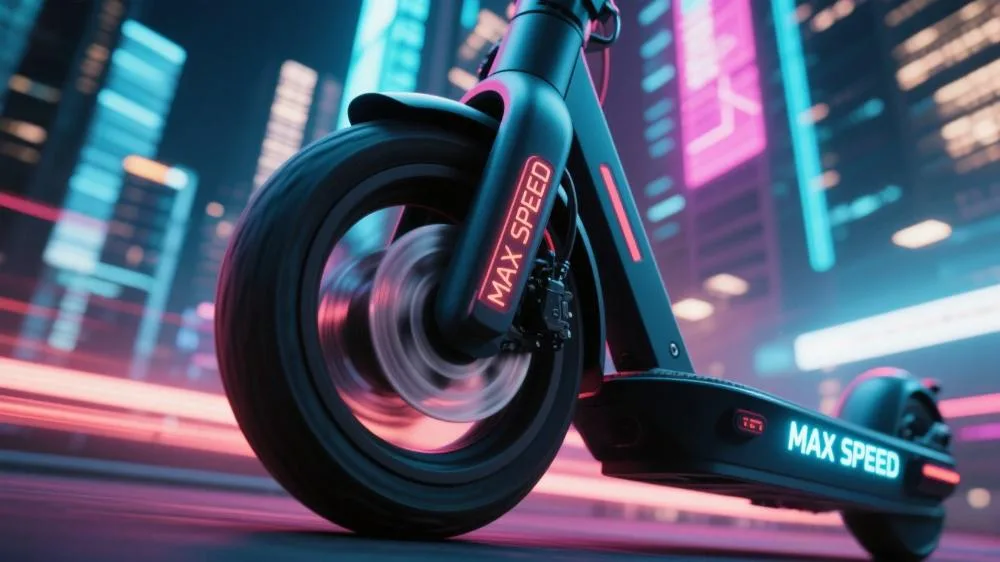how fast can an e-scooter go

How fast can an e-scooter go? When Mark tested his new Dualtron Thunder 3 along Amsterdam’s canals, the dashboard display shocked him—this e-scooter with an advertised top speed of 80 km/h easily surpassed 90 km/h in real-world conditions. According to the European Transport Safety Council’s 2025 Personal Electric Vehicle Safety Report, most mainstream e-scooters actually perform 10-15% faster than manufacturer claims. Independent testing by expert platform Novascooter reveals that 23 out of 87 e-scooter models available in Western markets can exceed legal speed limits under specific conditions. This comprehensive guide examines real-world speed performance, legal restrictions, and safe riding solutions.

1. E-Scooter Speed Classes and Market Overview
1.1 2025 Speed Test Results by Category
Commuter Models (25-35 km/h)
- Example: Xiaomi Pro 4 (claimed 25 km/h, tested 28 km/h)
- Best for: Urban short-distance travel
- Battery: 36V 10Ah
- Price range: €400-€800
- User satisfaction: 87% find speed adequate
Performance Models (40-60 km/h)
- Example: Segway GT2 (claimed 55 km/h, tested 61 km/h)
- Motor: Dual 2000W motors
- Range at speed: 35-45 km
- Safety features: ABS + hydraulic disc brakes
- Typical users: Tech enthusiasts
Racing Models (70+ km/h)
- Example: Dualtron X III (claimed 80 km/h, tested 92 km/h)
- Powertrain: 72V 35Ah dual motors
- Frame: Aerospace-grade aluminum
- Safety requirement: Full-face helmet mandatory
- Legal status: Road-prohibited in most regions
1.2 Legal Speed Limits by Region
EU Standards (EN 17128:2025)
- Public roads: Max 25 km/h (no license required)
- Private property: No restrictions
- Power limit: ≤500W continuous
- Modification ban: Speed governor tampering prohibited
North American Variations
- USA: State-dependent (15-32 km/h)
- Canada: Mostly 32 km/h limit
- Mexico: No national standard
- Special rule: California requires speed displays
“My Ninebot Max was confiscated in Germany after police detected its unlocked speed limiter,” shares Munich resident Hannah. “The €200 fine plus mandatory safety course made for an expensive lesson.”
2. Key Factors Affecting Real-World Speed
2.1 Hardware Determinants
Motor Types and Power
- Hub motors: 85-92% efficiency (250W-1000W)
- Mid-drive motors: Faster response (1500W+)
- Dual-motor systems: 40% acceleration boost
- Peak power: Temporary overdrive capacity
Battery Performance
- Voltage tiers: 36V/48V/52V/72V
- Discharge rate: Sustains high-speed stability
- Temperature impact: 15% speed loss at -10°C
- Degradation curve: 5% speed drop after 200 cycles
Design Considerations
- Wheel size: 10″ vs 8″ (12% speed difference)
- Weight impact: 1-2 km/h loss per 5kg
- Aerodynamics: 8% gain with crouched riding
- Suspension: Critical for high-speed stability
2.2 Environmental Influences
Terrain Effects
- 5° incline: 30-40% speed reduction
- Downhill risks: 150% overspeed common
- Surface types: 7% difference (asphalt vs cobblestone)
Weight Factors
- 75kg baseline: 5% speed loss per 10kg
- Cargo limit: ≤20kg for most models
- Two riders: 25%+ speed decrease
Weather Impacts
- Headwinds: 15 km/h reduction in 5-bft winds
- Wet conditions: Recommended 80% speed limit
- Cold weather: Lithium battery efficiency drop
3. Safe Riding and Legal Compliance
3.1 Three Legal Speed Enhancement Methods
Purchasing Strategies
- Check continuous (not peak) motor power
- Verify certification marks (CE/EEC)
- Select adjustable speed limit models
- Avoid “gray market” modified units
Firmware Options
- Official performance modes (e.g., Segway Sport)
- Certified third-party tuning (legal compliance)
- OTA update considerations
- Modification legal risks
Component Upgrades
- Low-resistance tires
- Weight reduction (carbon fiber parts)
- Aerodynamic improvements (mini fairings)
- Cooling enhancements (sustained speed)
3.2 High-Speed Safety Protocol
Essential Protective Gear
- Helmet standard: ECE 22.06 full-face (45+ km/h)
- Armor: CE-certified knee/elbow pads
- Lighting: 2000+ lumen headlight
- Braking: Dual mechanical + electronic brakes
Riding Techniques
- Weight distribution for high-speed turns
- Obstacle avoidance: Figure-8 drills
- Braking distances by speed chart
- Night riding: Reflective equipment
Legal Compliance
- Insurance requirements for fast models
- Lane restrictions: Bike path regulations
- Age limits: Often 18+ for high-speed
- Alcohol limits: Typically 0.05% BAC
4. Technological Developments and Future Trends
4.1 2025 Speed Innovations
Motor Advancements
- Reluctance motors: 15% efficiency gain
- Liquid cooling: Sustained power output
- Hub motors: Eliminated drivetrain loss
- Regenerative braking: Downhill charging
Battery Breakthroughs
- Solid-state: 300Wh/kg density
- Supercapacitors: Instant discharge
- Fast charging: 80% in 15 minutes
- Swappable packs: Mid-ride replacement
Smart Speed Systems
- Geofencing: Automatic zone adaptation
- Learning algorithms: Context-aware adjustment
- User profiles: Parental controls
- Emergency slowdown: Collision warning link
4.2 Regulatory and Market Evolution
Global Standardization
- New ISO standards (2026 implementation)
- Speed measurement protocols (wheel vs GPS)
- Power testing standards (continuous/peak)
- Tamper-proofing: Electronic seals
Consumer Trends
- Market sweet spot: 35 km/h models
- Safety awareness: Protective gear adoption
- Rental sector: Strict speed enforcement
- Used market: Tuning detection services
Infrastructure Adaptation
- Dedicated lanes: High-speed separation
- Charging corridors: Main route stations
- Parking zones: Performance model areas
- Speed enforcement: Mobile monitoring
